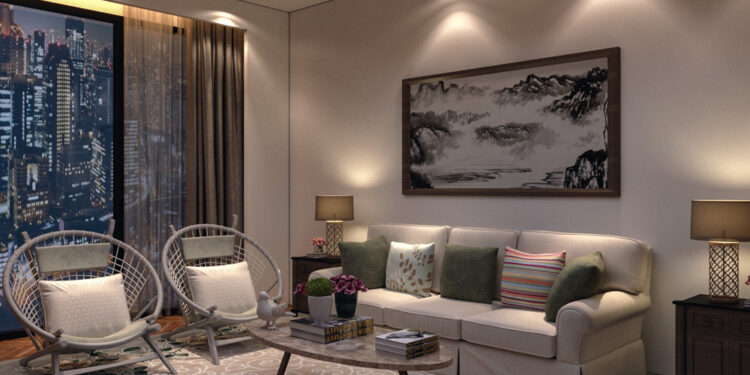A well-designed interior is more than an aesthetic statement; it shapes emotions, enhances functionality, and reflects personal or brand identity. Thoughtful interiors consider space planning, lighting, material selection, and furniture placement, ensuring harmony between form and function. Each element plays a role in crafting an environment that feels refined, comfortable, and purposeful.
Understanding Space and Proportion
Every interior begins with a fundamental understanding of space. A well-proportioned room feels balanced and inviting, regardless of size. The key lies in defining zones for different activities, ensuring seamless movement, and maintaining visual cohesion.
-
Open-Plan Designs: Ideal for modern living, open spaces promote connectivity and a sense of fluidity. However, they require careful zoning through furniture placement, rugs, or subtle architectural details to avoid a sense of emptiness.
-
Intimate Spaces: In contrast, smaller rooms benefit from strategic layout planning. Multi-functional furniture, clever storage solutions, and carefully chosen color palettes can enhance the perception of space without compromising comfort.
-
Proportion and Scale: Every piece within a room must relate to its surroundings. Oversized furniture in a compact room can overwhelm, while delicate pieces in a vast space may appear insignificant. Achieving balance ensures a room feels curated rather than chaotic.
The Power of Lighting in Interiors
Lighting is a defining factor in any interior, shaping mood, highlighting architectural features, and enhancing usability. It is essential to layer lighting for both aesthetics and practicality.
-
Ambient Lighting: The primary source of illumination, whether through ceiling fixtures, recessed lighting, or natural light. Its intensity should be adjustable to suit different times of day and activities.
-
Task Lighting: Focused lighting enhances functionality in areas such as kitchens, workspaces, or reading nooks. Table lamps, under-cabinet lighting, and pendant lights over counters serve both practical and decorative purposes.
-
Accent Lighting: Designed to highlight specific elements, such as artwork, textured walls, or statement furniture pieces. Wall sconces, LED strips, and track lighting add depth and visual intrigue.
A well-lit space embraces natural and artificial sources harmoniously. Maximizing daylight through reflective surfaces, sheer drapery, and strategically placed mirrors fosters a vibrant ambiance while reducing reliance on artificial lighting.
Material Selection: Texture and Character
The choice of materials sets the tone for an interior, influencing not just aesthetics but also comfort and longevity. A careful blend of textures creates an environment that feels layered and inviting.
-
Natural Elements: Wood, stone, and linen introduce warmth and authenticity. These materials age gracefully and add an organic touch to both contemporary and classic interiors.
-
Metallic Accents: Brass, bronze, and matte black finishes lend a sophisticated contrast when used sparingly in fixtures, hardware, or decorative elements.
-
Textiles and Upholstery: Soft furnishings contribute to comfort while adding color and pattern. Layering materials such as velvet, wool, and cotton enhances depth and visual interest.
-
Sustainable Choices: Responsibly sourced materials ensure that design choices are both beautiful and ethical. Reclaimed wood, recycled glass, and low-VOC finishes support environmental consciousness without sacrificing elegance.
Furniture: Function Meets Aesthetic
Selecting furniture requires a balance between style and purpose. A well-curated interior does not rely on excess but instead prioritizes pieces that serve both a functional and artistic role.
-
Statement Pieces: A striking sofa, sculptural coffee table, or artisanal chair can define a space while maintaining sophistication.
-
Versatility in Design: Modular furniture adapts to evolving needs, making it ideal for urban living. Nesting tables, expandable dining sets, and convertible sofas maximize usability without crowding a space.
-
Timeless Craftsmanship: Investing in high-quality pieces ensures durability and enduring appeal. Classic silhouettes, handcrafted details, and superior materials stand the test of time.
The interplay of furniture styles—whether modern, traditional, or eclectic—adds personality without feeling disjointed. A well-designed space feels intentional rather than trend-driven.
Color and Its Influence on Atmosphere
Color influences perception, affecting mood and spatial dynamics. Selecting the right palette requires understanding both aesthetic appeal and psychological impact.
-
Neutral Foundations: Soft tones such as beige, taupe, and warm greys provide a timeless backdrop, allowing architectural features and décor to stand out.
-
Bold Statements: Deep blues, emerald greens, and terracotta hues inject character when used thoughtfully—whether on an accent wall, upholstery, or decorative accessories.
-
Monochromatic Schemes: A single-color palette in varying tones and textures creates depth while maintaining a cohesive look.
-
Contrast and Balance: Pairing light and dark elements prevents a space from feeling monotonous. Dark furnishings against light walls or a vibrant rug in a muted setting adds visual intrigue.
The choice of color should complement natural lighting, ensuring that tones appear vibrant yet soothing throughout the day.
The Finishing Touch: Art and Décor
The final layer of an interior reflects personality and refinement. Art, accessories, and decorative details bring character to a space without overwhelming its essence.
-
Artwork and Sculptures: A well-placed painting or sculptural piece serves as a focal point, elevating the ambiance with a sense of curated taste.
-
Decorative Accents: Vases, books, and ceramics add layers of detail. Arranging objects in varying heights and textures creates a visually compelling composition.
-
Greenery and Florals: Plants introduce life, freshness, and a connection to nature. From large potted trees to delicate floral arrangements, greenery enhances any setting.
Interiors should feel intentional, balancing artistry with comfort. A well-designed space is not defined by opulence but by the thoughtfulness behind each element, resulting in an atmosphere that is as functional as it is beautiful.







